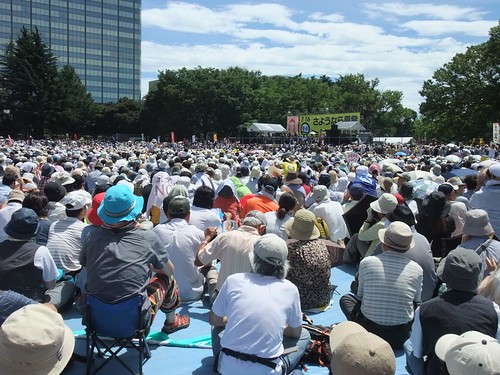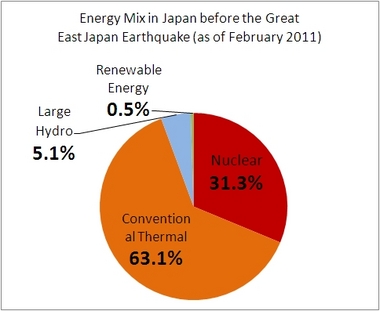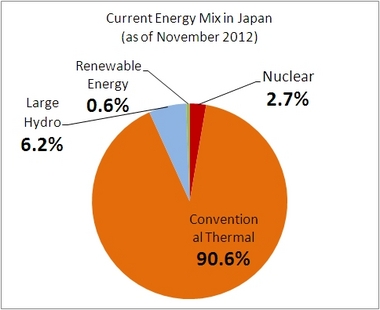March 1, 2013
Japan's Energy Situation after the Great East Japan Earthquake
Keywords: Newsletter Nuclear Power
JFS Newsletter No.126 (February 2013)
Since the Great East Japan Earthquake occurred on March 11, 2011, and the subsequent nuclear accident at Tokyo Electric Power Company's Fukushima Daiichi nuclear power plant, the energy situation (especially relating to electricity) in Japan has been evolving dramatically. In this article, I would like to look at the trends with nuclear power in Japan in the past two years, with our discussion divided into five phases.
Situation before the Great East Japan Earthquake
In February 2011, there were 54 nuclear power plants in Japan and the energy mix was comprised of 31.3% nuclear, 63.1% thermal (fossil-fuel burning power plants), 5.1% hydroelectric, and 0.5% renewable energy. Based on the government's Strategic Energy Plan formulated in 2010, the aim was to target about a 50% increase in the percentage of nuclear power generation of its total electricity generation in 2030. For that purpose it aimed at construction of more than 14 new nuclear power plants. The major rationale for this large proposed increase in dependence on nuclear power was the need to tackle climate change.
First Phase: After March 11, 2011, All Nuclear Power Plants Eventually Shut Down
Due to the Great East Japan Earthquake (combined disaster of earthquake and tsunami) that occurred on March 11, 2011, out of six reactors at the Fukushima Daiichi nuclear power plant, reactors 1 to 3 had core damage, loss of cooling function and reactor building damage, and among reactors 4 to 6, which were undergoing regular inspections at the time, reactor 4 also experienced a hydrogen explosion that severely damaged the reactor building.
For the Tokyo Electric Power Company, besides the four reactors of the Fukushima Daiichi nuclear power station, at the Fukushima Daini nuclear power plant all four nuclear reactors and six thermal power plants were damaged and forced to stop operations. The operation of four nuclear power plants managed by the Tohoku Electric Power Co. and one reactor of the Japan Atomic Power Company also stopped operations due to the earthquake. As electricity supply conditions were significantly impaired, scheduled blackouts (rolling blackouts) were introduced, which had great impact on the daily life of the population and caused serious economic impacts.
Nuclear power plants in Japan are subject to regular inspections every 13 months. As a result, plants in the country which did not stop due to the earthquake successively stopped operations for the periodic inspections, but due to the commotion and local concerns, the plants could not resume operations after their regular inspections. The result of this was that nuclear power's share of total electricity generation in Japan declined.
Second Phase: Launch of a Review of Japan's National Strategic Energy, and All Nuclear Power Plants Stop Operation
Then-Prime Minister Naoto Kan ordered a review of the country's Strategic Energy Plan from scratch -- and established the ministerial "Energy and Environment Council" in June 2011, setting forth as the basic principle "drawing scenarios that can reduce the dependence on nuclear energy." Under the Advisory Committee for Natural Resources and Energy, an advisory committee for the Minister of Economy, Trade and Industry, within the Agency for Natural Resources and Energy, the "Fundamental Issues Subcommittee" was established, consisting of 25 experts who started discussions on the best choice of energy mix (I was one of the Committee members).
During this phase, nuclear power plants across the country that were subject to periodic inspections could not resume their operations, so that dependence on nuclear power declined rapidly. By May 5, 2012, not a single nuclear power plant in Japan remained in operation. At the same time, the share of thermal power plants for the electric power supply increased, so the imports of oil and liquefied natural gas (LNG) increased rapidly as well. As a result, Japan fell into a trade deficit in 2011, for the first time in 31 years.
Third Phase: Protests Against Restarting Oi Nuclear Power Plant, and a National Debate on Energy Policy
The Kansai Electric Power Co. was particularly vociferous in its calls for permission to resume operations, as it is highly dependent on nuclear power, and the high costs of substitute fuels for power generation were affecting its bottom line, even with power saving programs in place. The company had a 15% shortfall in its supply versus demand, and could not avoid rolling power blackouts.
Meanwhile, the Kansai Electric Power Co. submitted a preliminary reactor stress test report for reactors 3 and 4 at its Oi nuclear power plant. The test measures whether serious accidents might occur in nuclear power plants in case of a disaster greater than under conventional safety standards. The government and the Japan Nuclear Safety Commission determined that the findings were "reasonable," but the Union of Kansai Governments, which consists of seven prefectures and four cities (Shiga Prefecture, Kyoto City, etc.) in the Kinki, Chugoku and Shikoku regions of Japan, neighboring the Oi nuclear power plants, strongly opposed the resumption of operations. A deadlock resulted. But the Union of Kansai Governments relented at the end of May, with a sudden de facto approval of the reactivation, and reactors 3 and 4 resumed operation in July 2012. (At the time of writing, these are the only two nuclear power plants operating in Japan.)
Many people participated in protests against resuming the Oi nuclear power plant operations. A large anti-nuclear protest/demonstration started to be held in June 2012 in front of the Prime Minister's official residence almost every Friday. The protest organizers announced that one day about 200,000 people participated, while police put the number at 17,000. As to the "100,000 People's Assembly to say Goodbye to Nuclear Power Plants" held at Yoyogi Park on July 16, organizers announced that about 170,000 people participated, while police put the number at about 75,000. Protest movements had been relatively dormant in Japan in recent years, but are now receiving much attention as a new phenomenon.
At the end of May 2012, based on alternative proposals for an energy mix submitted by the Fundamental Issues Subcommittee, the Energy and Environment Council presented three choices to the public at the end of June, with the intention that "public debate" would lead to final decisions in August.
"Deliberative opinion polls" were carried out as a new attempt to gather opinions from the public. "Public comments" were accepted. And "public hearings" were held in 11 places around the country. The survey results showed that one of the alternatives, the Zero Scenario (zero nuclear power by 2030), showed higher support than other alternatives, drawing the support of 47% of the deliberative polling respondents, 68% of public hearing participants, and 87% in public comments.
[A note on deliberative polling: Ordinary citizens, randomly selected, are first polled on issues and some are chosen to be participants in a discussion forum. They are given information on the issues in advance. At the forum, after small group discussions a general assembly can ask experts questions. After the discussion forum, participants are again polled on the same issues and the resulting changes in responses are analyzed.]
As a result, the Energy and Environment Council adopted "An Innovative Strategy for Energy and the Environment" on September 14, 2012. Its preamble stated the need to "create a society that does not depend on nuclear power plants as soon as possible." The Council adopted text recommending that Japan invests in "all sorts of policy resources to make it possible to reduce nuclear power plant operation to zero by 2030," considering the following guiding principles: (1) "strictly enforce regulations limiting the operation of nuclear power plants to 40 years," (2) "restart the operation only of plants that receive safety assurance from the Nuclear Regulation Authority," and (3) "prohibit new construction and expansion of nuclear power plants."
Fourth Phase: Future of Energy Policy and Nuclear Power Plants Gets Complicated Due to Political Chaos
The industry sector and local governments where nuclear power plants are located were strongly opposed to the "Innovative Strategy for Energy and the Environment." Due to the strong opposition, at a ministerial-level meeting on September 19, 2012, the Cabinet was unable to approve the Strategy, and decided to treat it only as a reference document.
After that, the Fundamental Issues Subcommittee held no further meetings, and while energy policy discussions stagnated, Japan held general elections on December 16 for the House of Representatives (the lower house of Japan's parliament).
During the election campaign, the then-ruling Democratic Party of Japan pledged to reduce nuclear power operation to zero by the 2030s. The newly-created Tomorrow Party of Japan, also referred to as the Japan Future Party (in Japanese, the Nippon Mirai no To), attempting to create a third main voice in Japanese politics, talked about "graduating from" nuclear power as a part of its platform. Meanwhile, the Liberal Democratic Party (which had previously ruled the country almost continuously from the end of the Second World War until 2009) simply offered "to establish the best mix of the energy structure within the next 10 years," and did not offer any medium-term policy direction for nuclear power.
Fifth Phase: The Liberal Democratic Party to review the policy to make zero nuclear power operation
The election gave the main opposition party, the Liberal Democrats, 294 seats to ensure an absolute majority (269 seats were required). Combined with Komeito's 31 seats won, this bloc has 325 seats, more than the two-thirds majority of the House of Representatives vote needed for bills to be passed. In effect the LDP has recaptured the political regime.
The "Second Abe Cabinet" (Shinzo Abe had already served as Prime Minister once before) was inaugurated on December 26, 2012. At the end of January 2013, he declared his intention to review the Democratic Party of Japan's previous target to reduce nuclear power plant operation to zero, and called it a "zero base review," meaning starting from scratch. The Ministry of Economy, Trade and Industry then decided to begin discussion on the Strategic Energy Plan by March 2013. The Ministry decided to set up an expert committee, different from the discussions developed by the Fundamental Issues Subcommittee (the one of which I had been a member).
The current mix in Japan is composed of just 2.7% nuclear, with only two nuclear reactors in operation, 6.2% hydro, 0.6% renewable, and 90.6% thermal power.
The business conditions of electric power companies are getting worse due to a dramatic increase in LNG and other fuel costs. If we look at consolidated accounts of the 10 major electric companies for the period April to September 2012, among the nine companies with nuclear power plants, eight of them recorded losses. The larger the dependency on nuclear power, the greater the losses. Besides the Tokyo Electric Power Co., which has already decided to raise electricity rates, four other companies have applied for price increases. The industrial sector has especially shown anxiety and opposed price increases, saying that if electricity prices go up, all profits will be lost, and it will no longer be possible to do business in Japan.
Future Trends
On one hand, nearly all nuclear power plants in Japan have been shut down, while renewable energy is being taken more seriously and getting policy support. But renewables are still not large enough to replace nuclear power. (Had this shift begun 10 years ago, renewables would be a bigger part of the energy mix by now). Also, energy conservation will be the most effective remedy in the short term. The investments pay for themselves eventually, but policy support for backing up the initial investment is not sufficient at the moment.
According to the most recent national annual poll (by telephone) by the Asahi Shimbun Newspaper, conducted on February 16 and 17, when given five choices for the future of nuclear power, here were the answers: "stop immediately" by 13% of respondents, "stop before 2030" by 24%, "stop in the 2030s" by 22%, "stop after 2030" by 12%, and "don't stop" by 18% . In total, 71% said "stop," compared to the 18% who said "don't stop."
Concerns and fears about nuclear power accidents and distrust in government and industry managers have not yet gone away. The population continues to loudly articulate a desire for a "non-nuclear future," but for the time being Japan will have to rely on the main alternative -- thermal power generation (fossil fuels) -- if it is to replace nuclear power. With rising concerns about the effects on the life of the population and industrial sector of increased procurement costs of 3.2 trillion yen (about U.S.$360 billion) a year through electricity price hikes, the pressure to resume operations is increasing. The current government stance is that Japan's Nuclear Regulation Authority is to announce safety standards in July 2013, and nuclear power plants that comply with the standards will resume operation.
As to energy policy and the future of nuclear power, I believe that there is a need to separate the discussion into short-term actions and medium-term actions. The argument that says that the "Abenomics" (named after the new Prime Minister) policy of increasing electric power prices is an attempt to break away from deflation is partially right. But the Oi nuclear plant resumed operations due to "the need to survive the summer power crunch" in 2012. People concerned about nuclear power have some mistrust and fear that if we allow it to continue operating, under the excuse of allowing nuclear plants to resume operations to meet short-term needs, this could lead back to full-scale promotion of nuclear power.
I join many others in hoping that Abe's new expert committee, set to launch in March 2013 to discuss the Strategic Energy Plan, will discuss policies to address short-term and medium/long-term needs while sharing the overall picture with the entire nation.
Written by Junko Edahiro
Here's a list of JFS's past articles regarding energy policy situation in Japan after the Great East Japan Earthquake in 2011
Japan's Strategic Energy Plan under Review after 2011 Nuclear Disaster
Re-Examining GDP Growth Projections to Plan Japan's Future Energy Policy
Listening to the Voices of the Young Who Will Lead Society in 2030 -- A Meeting to Consider Energy Issues from the Perspective of Today's Youth
[Press release] 70% of Global Survey Respondents Support the No Nuclear Policy Scenario by 2030
Update on the Discussion in Japan on Energy and Environment Policy Options to 2030
Update on Planning Japan's Energy Future to 2030
Related
"JFS Newsletter"
- 'Good Companies in Japan' (Article No.4): 'Eightfold Satisfaction' Management for Everyone's Happiness
- "Nai-Mono-Wa-Nai": Ama Town's Concept of Sufficiency and Message to the World
- 'Yumekaze' Wind Turbine Project Connects Metro Consumers and Regional Producers: Seikatsu Club Consumers' Co-operative
- Shaping Japan's Energy toward 2050 Participating in the Round Table for Studying Energy Situations
- 'Good Companies in Japan' (Article No.3): Seeking Ways to Develop Societal Contribution along with Core Businesses





